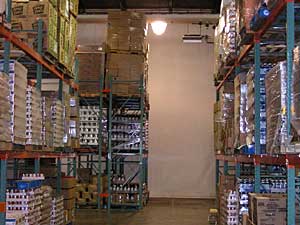Food banks see downturn in corporate donations
November 22, 2004
 |
| All of this food will be distributed this month and will need to be replaced. (MPR Photo/Bob Reha) |
Moorhead, Minn. — Second Harvest, Minnesota's largest food bank, helps people in 61 counties in eastern Minnesota and western Wisconsin. Jerry Hedum, manager of Second Harvest, says the amount of food his organization distributes, might shock some people.
"Last year, Second Harvest distributed over 30 million pounds of food," says Hedum. "Most people know what a pallet of food looks like. If you put all the food that we distributed last year (together), it would be 153 times the height of the IDS building."
Second Harvest is dependent on donations of food. Rice, pasta, milk and other items are needed on a daily basis. In the past, food banks have gotten the surplus from major food manufacturers. But Hedum says in a weak economy, surplus items that normally would be donated, have found a new market.
"A secondary market is (what) we call it stress food, where it's getting close to code (expiration) or maybe the label's not on right," says Hedum. "They'll buy volumes of that. That's what you see in a lot of dollar stores that are popping up, it's really cut into our task as far as sourcing food."
 | |||
While a slow economy is forcing some corporate donors to cutback on their giving, others are picking up the slack. Susan Worwa, spokesperson for Golden Plump Chicken, says the St. Cloud-based company will donate five semi-truck loads of chicken to Second Harvest this year.
She says the total donation in food and cash will be close to half a million dollars. That's more than the company gave last year. Worwa says the company has a long- term commitment to helping fight hunger.
"There have been times in the not-too-distant past, where the company has not been profitable, but what the company has donated toward hunger relief hasn't changed," says Worwa.
Despite the generosity of some, it's not enough. Food banks across the region are struggling to keep pace with demand. The Great Plains Food Bank in Fargo, North Dakota is no exception.
Boxes of pasta, cereal and other food items are stacked from the floor to the ceiling of the agency's warehouse. There's so much food, workers need forklifts to load trucks for deliveries.
A walk-in freezer stores frozen foods like ice cream, and meat. It's an impressive sight. Steve Sellent, director of the food bank, says all this food will be gone in a month and need to be replaced. Sellent says it's a tough job. He says big food companies are changing the way they distribute their product and it affects donations.
"A lot of companies used to manufacture it,(they'd) keep it in their warehouse and then distribute it directly to the customers," Sellent says. "Now a lot of those big manufacturing places, are sending it to distribution outlets, maybe on the east and west coast, closer to the customer. So when there's a surplus or something's not moving, it's getting donated out from those distribution centers, rather than from the manufacturing plants in North Dakota, which used to donate to us."
 | |||
Sellent says the changes have a ripple effect on all the agencies dependent on the food bank. Elizabeth Swee, director of the Dorothy Day food pantry in Moorhead, says if food isn't availible from the food bank, her organization has to find other sources. Food drives sponsored by churches or civic groups pickup the slack.
"From now until Christmas, will be really good, because people are focused on feeding others who don't have anything," says Swee. "The holiday drive kind of thing. Then in March, we have Minnesota Food Share, where everything that comes in, is counted and matched by corporate sponsors."
Swee says it's always a struggle to meet demand. But she says there is hope. She's encouraged by the young people who volunteer at the food pantry. She says that shows there is a growing awareness among kids that many of their neighbors and friends need help.
|
News Headlines
|
Related Subjects
|
